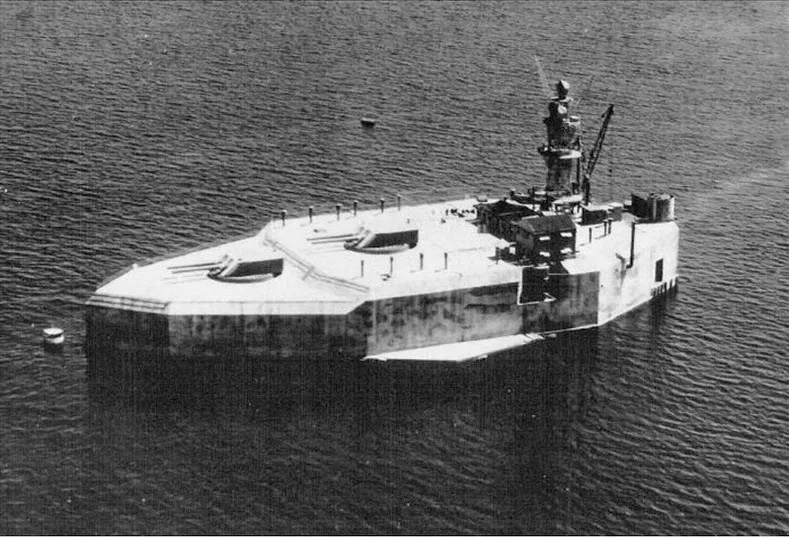
Before the advent of maneuver warfare, nations defended their territory with massive fortifications. This was particularly true of coasts and harbors, especially if a nation owned the finest harbor in the Orient. This was the case for the American port at Manila Bay.
After the United States acquired the Philippines from Spain during the Spanish-American War, the U.S. Board of Fortifications recommended that important harbors be fortified. This led to the development of defenses on several islands at the mouth of Manila and Subic Bays. One of these was El Fraile Island which would later become Fort Drum, America’s concrete battleship.

While other islands were fortified by more conventional means, the plans for El Fraile were much more extensive. Construction began in 1909 and completed by 1916. What was originally a rocky outcropping of an island was excavated down to the waterline. From there, the concrete battleship began to take shape.
The new structure was 350 feet long and 144 feet at the widest point. The exterior walls of the fortification were constructed of reinforced concrete 25 to 36 feet thick and rising 40 feet above the water. The top deck of the structure was reinforced concrete 20 feet thick that mounted two turrets containing twin fourteen inch guns and a 60 foot fire control tower to complete the battleship look.
The fort’s armament was rounded out by dual six-inch guns in armored casemates on each side as well as three-inch anti-aircraft guns mounted on the top deck. The fort’s 240 officers and enlisted lived deep inside the impregnable walls of the concrete ship along with all the stores they would need to hold out against a siege.

That siege came after the Japanese invaded the Philippines in December 1941. In January 1942, the Japanese began to target Fort Drum and the rest of the harbor defenses from the air and by February the concrete battleship was in range of Japanese artillery on shore. The fort endured bombing and shelling, destroying the anti-aircraft batteries, temporarily disabling a six-inch gun, damaging its casemate and searchlight, chipping away large chunks of concrete.
The whole time Fort Drum was under attack, it returned fire against the Japanese. The fort’s resistance continued even after the fall of Bataan on April 10, 1942 left Fort Drum and the other islands of the harbor defense as the last American forces in the Philippines. The guns of the concrete battleship dealt serious blows to Japanese forces assaulting the island of Corregidor, inflicting heavy casualties.
Unfortunately for the men of E battery, 59th Coastal Artillery, their efforts were not enough to halt the Japanese onslaught as General Wainwright made the decision to surrender the remaining U.S. forces in the Philippines. However, the fort was never taken and its main guns were still firing five minutes before the surrender was announced.

After capturing the Philippines, the Japanese manned all former American positions, including the concrete battleship. Eventually, American forces recaptured Manila and a daring assault by the 503rd Parachute Infantry Regiment U.S. forces recaptured Corregidor as well. That left Fort Drum once again as the last bastion of resistance. However, unlike the Americans some three years earlier, the Japanese had no intention of surrendering. This combined with the fact that the Americans had designed the fort to resist all manner of bombings and gunfire meant they would have to find another way to remove the defenders.
Unfortunately for the Japanese manning the concrete battleship, the idea the Americans came up with was rather grisly. The troops poured a mixture of two parts diesel oil and one part gasoline into the fort, lit it, and burned the defenders alive. The fire burned for several days afterwards but all the defenses of the harbor had been cleared of Japanese. The fort has never been reoccupied and still stands like a ghost ship in Manila Bay to this day.
